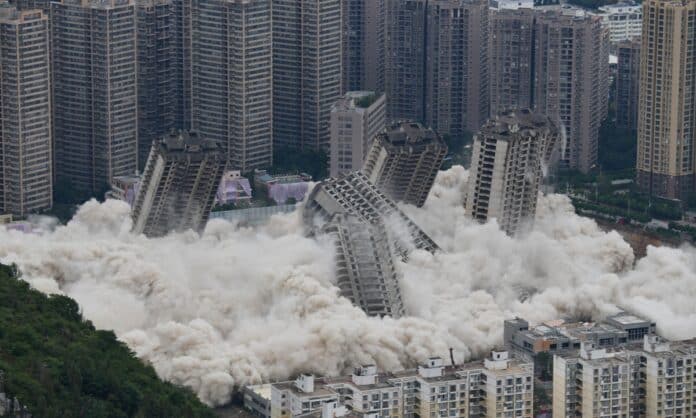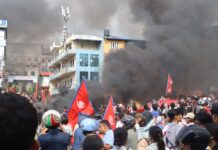Property collapse deepens while concerns rise over slow and limited government intervention
Editorial from issue 71 Socialist《社会主义者》magazine, the magazine of ISA in China, Hong Kong and Taiwan
China’s economic crisis entered a new more dangerous phase in August. Despite a tightening government clampdown on negative news, the overall picture is darkening week by week as China’s biggest property company Country Garden teeters on the brink of default and signs of distress spread to the financial sector.
After three years of brutal lockdowns, an economic recovery was widely predicted (not by us, it should be noted). But much like China’s foreign minister, the post-COVID rebound has vanished without trace. This is not just about a failed recovery. China’s authoritarian capitalism faces a systemic crisis after several decades of rapid but unsustainable debt-driven growth. The property sector is the “most important single sector of the global economy,” according to Fitch, a US credit ratings agency. Its close relationship with China’s local governments, which relied on land sales to the developers for almost half their revenue, has been central to the CCP’s (so-called Communist Party) economic model of state capitalism.
As Nomura’s chief China economist Ting Lu recently stated, “We reckon that markets still underestimate the aftermath of the significant collapse in China’s property sector, which accounts for more than half of global new home sales and home building.”
New home sales at China’s 100 biggest developers contracted by 33 percent in July from a year earlier, after a fall of 28 percent in June. It is realistic to assume that the housing market in terms of housing built and sold is one-third smaller than in 2021. This is also aggravated by China’s demographic crisis, with a net outflow of residents from many third and fourth tier cities especially. 266 cities saw their population fall between 2010 and 2020, according to researchers at Tsinghua University.
As part of the worldwide crisis of capitalism, the CCP’s state capitalist model was already broken before the pandemic. The CCP’s brutal countermeasures (zero-COVID) further exacerbated the crisis. Belatedly, with the failure of the post-COVID rebound, more and more capitalist commentators are coming to similar conclusions to those chinaworker.info reached years ago. We recognised that the era of rapid Chinese growth is over and a long-term process of economic ‘Japanification’ – stagnation, debt crisis and demographic decline – has set in. Marxist analysis is the superiority of foresight over astonishment.
Today there is disbelief and despair among the capitalists at the weakness of the policy response from Xi Jinping’s regime. Previously, many overseas capitalists expressed admiration for the CCP dictatorship for “getting things done”. They overestimated the ability of the dictatorship to escape capitalism’s crises. But unlike in previous downturns there is no sign of a major stimulus package – a fiscal ‘bazooka’ – like the one launched 15 years ago by Wen Jiabao, which “saved the global economy” according to some.
Hiding the facts
Instead, the dictatorship is relying even more on the manipulation or banning of unflattering economic data. From August, the regime announced it was suspending the collection of data on youth unemployment. In April a consumer confidence index was discontinued. Data for land sales by local governments is also no longer available. Finance writers have had their Weibo accounts closed down for spreading “negative and harmful information”. And journalists have been ordered not to use the word deflation. “Generally speaking, there is no deflation in Chinese society, and there won’t be in the future,” declared Fu Linghui of the National Bureau of Statistics on July 17.
The topics being banned tell us that the real situation is much worse than the official reports. In July, the youth unemployment rate hit a record 21.3 percent. Shocking as this is, it’s also a significant undercount. A widely circulated but deleted report from Peking University professor Zhang Dandan estimated that the real youth unemployment rate was 46.5 percent.
Prior to 2020, retail sales growth was running at 9-10 percent yearly, but is currently an anaemic 2.5 percent. The lack of demand is linked to the taboo topic of deflation: the consumer price index fell 0.3 percent in July, with the producer price index falling 4.4 percent, the tenth consecutive monthly decline. Land sales data for the whole of 2022 showed a 50 percent contraction. But local government income from land sales reportedly fell only 23 percent. Clearly, this doesn’t add up.
Discontinuing the collection of youth unemployment data is perhaps the most revealing act of censorship. With possibly half of under-25s out of work, a youth explosion is a real possibility in the coming period, as indicated by the short-lived wave of protests at the end of last year. Of course, this has severe implications for Xi’s hardline rule. With the sacrifices and suffering of the masses during three years of excruciating pandemic controls giving way to economic burdens and uncertainty not seen in almost forty years, mass anger and frustration threaten to boil over on a scale not seen before.
Every social class is worse off now than before the pandemic, with big pay cuts for factory workers and government employees, a wave of factory closures, ruined small businesses, and tens of millions of homeowners paying mortgages on homes in ‘negative equity’. Xi’s regime blames these economic hardships on the anti-China policies of U.S. imperialism and the West’s decoupling agenda, attempting to firm up nationalist support. But while this propaganda can have an effect on some sections of the population, it has limits as the economic crisis deepens.
Why no massive stimulus?
The capitalists are alarmed: What has happened to the CCP’s legendary ‘financial toolbox’, which it has used to dig itself out of trouble time after time? This absence shows that the crisis is different today. Critical levels of debt throughout the economy (a record 295 percent of GDP at the end of 2022) have crimped the regime’s room to manoeuvre – the old methods are no longer possible or no longer have the desired effect.
According to Professor Zhang Jun of the China Centre for Economic Studies: “China’s move away from aggressive macroeconomic policy could be attributed to the leadership’s recognition of the threat posed by the country having reached a critical threshold of systemic financial risk a few years ago. Given the nature of the Chinese political system, such risks would be deemed to pose an unacceptable threat to social and political stability.” (South China Morning Post, 29 August 2023).
China’s economy: What happened to the rebound?
Massive spending on infrastructure has been the CCP’s default response, rather than resorting to ‘helicopter money’ – printing money and distributing it to the public in order to spur consumption. The latter approach was favoured by many other capitalist governments during the pandemic. This idea is now being floated by some in China. A think tank affiliated with Renmin University, China Macroeconomy Forum, recently urged the government to spend 1.5 trillion yuan (US$200 billion) annually to give around 1,000 yuan in subsidies to every citizen in the form of digital yuan.
For the CCP leaders this approach risks falling into the trap of ‘welfarism’, which in its mindset fosters ‘laziness’. Xi Jinping’s aversion to ‘welfarism’ was spelt out in a speech published in the CCP journal Qiushi in October 2021. The dictatorship fears that one-off payments to ordinary households will not substantiually increase consumption, while widening the budget deficit and opening the door to demands for more social spending, improved pensions, medical and unemployment insurance. Deciding how much households should get would be hugely problematic in a society with extreme regional disparities and wealth inequality (the top 1 percent hold a bigger share of national wealth than the bottom 50 percent), with the risk of igniting social unrest.
By contrast, the traditional approach – another infrastructure spree – enriches local CCP officials and capitalists. Or so it was, until extreme levels of overconstruction in housing and infrastructure, and the corresponding debt crisis in local governments, effectively closed this option. An example from one of the most indebted provinces, Guizhou, illustrates the absurdities of the CCP’s policies. According to the South China Morning Post (30 July, 2023), Guizhou had built a total of 8,331km of highways by the end of 2022, exceeding Japan’s 7,800km. Japan has 82 million vehicles while Guizhou has less than six million, and its GDP is more than 15 times greater than Guizhou’s.
Given the increasingly precarious state of the financial system, unprecedented levels of overcapacity and the other factors mentioned above, a “big bang” stimulus is very unlikely. If despite this the CCP regime finally produces such a package it will signify a raging power struggle and historic crisis at the top, and represent a huge gamble that could backfire to produce an even worse outcome.
Without major financial stimulus, the government is restricted to issuing one “confidence boosting package” after another, largely focused on calming the financial markets. These packages have arrived almost one per week since the middle of July but contain only limited or peripheral measures. This has become an exercise in economic filibuster leaving the “market” less and less impressed. The CSI300 stock market index fell 6 percent in August despite the CCP’s wasteful (and not cheap) efforts to manipulate it in the other direction.
China’s economy is hard pressed from all directions with what some English language commentators are calling the four “D’s”: demand, debt, demographics and decoupling. As Marxists have explained, the decoupling process (or ‘de-risking’ for the squeamish) is real. The imperialist power struggle between China and the U.S. with their respective Cold War blocs is now relentlessly imprinting itself on trade relations, supply chains (‘reshoring’ and ‘friend shoring’) and investments. It doesn’t mean a total embargo on trade between the two camps of course, nor will the process be linear. Nevertheless a powerful shift towards reduced mutual connectivity is underway. Both sides are erecting barriers, stricter regulatory regimes, and increasingly diverting trade and investment into their own blocs or to ‘friendly’ countries.
China’s trade this year with the Belt and Road countries of Asia, Africa and Latin America is for the first time greater than with the advanced capitalist states of the U.S., EU and Japan. China’s exports to the U.S. fell 25 percent during the first six months of 2023, the U.S. Commerce Department reported. The U.S. now counts Mexico as its number one trade partner, with China down to third place.
In China’s case this shift from wealthier to less developed export markets will inevitably increase its own economic difficulties. It is accompanied by a U.S.-coordinated tech war to cut China’s access to key U.S.-controlled technologies, with the aim of opening a bigger gap between them especially in military technologies. For Chinese workers the impact is already measurable with factories closing in China and moving to India, Vietnam and Indonesia under a ‘China plus one’ or ‘China plus two’ strategy. This process is likely to accelerate, driven by geopolitics and plain old capitalist greed (there are many cases of Chinese capitalists shifting production from China and hopping on the decoupling bandwagon).
Marxist perspectives
The dire state of the economy confirms the warnings of chinaworker.info and our international organisation ISA. We stressed that the capitalists including Xi Jinping’s regime had hugely underestimated the impact of the property sector’s implosion, that it was a turning point for China and world capitalism. Inevitably this crisis would spread to other sectors of China’s economy, like dominos falling, most immediately to local governments and their financial vehicles (LGFVs), which are based on land price speculation.
We warned that China’s economy was following in broad outline the process of ‘Japanification’ – a prolonged phase of stagnation following the collapse of huge asset bubbles, primarily the Japanese property sector, which began in 1990. “The world is finally awakening to challenges that have been building in China for years,” commented a Bloomberg report in August.
Today, much media commentary is focused on China’s ‘Japanification’, with economists like Paul Krugman, Stephen Roach, Michael Pettis and reports from big banks JPMorgan and Citigroup largely supporting this diagnosis. Krugman and others warn that China’s crisis will likely be worse than Japan’s, notwithstanding that Japan’s GDP growth averaged 1.3 percent annually during the 1990s, and China may achieve a higher rate (2 to 3 percent). There is a strong case here. China is much poorer – its GDP per capita was around US$12,800 in 2022, compared to US$29,470 in Japan in 1991. China’s welfare levels are vastly inferior. Its demographic crisis is bigger and began at an earlier stage than Japan’s, whose population did not begin to shrink until 2008.
China was overtaken by India this year as the world’s most populous country, but there is evidence to suggest this shift took place earlier, perhaps already in 2018. Again, the CCP regime has manipulated the data. Under capitalism this is a problem, because China’s labour force is shrinking by several millions workers every year while its underfunded pension system is another potential domino waiting to topple. On current trends it won’t be able to pay out to the projected 400 million retirees in 2033.
China also of course lacks the ‘pressure valves’ of bourgeois democracy that can help the capitalist class to contain and divert mass anger. A crucial difference is that Japan in the 1990s, although involved in trade disputes with U.S. imperialism, was not locked in a no-holds-barred Cold War conflict as China is today. The Cold War is itself a result of China’s much bigger global role than Japan’s at that time and the much bigger threat this poses to U.S. dominance. In this conflict, Xi’s regime does not have the option of stepping back, apart from temporary tactical manoeuvres to win time. For both imperialist camps the only way out of the conflict is victory or capitulation, a historic defeat. Therefore, notwithstanding the depth of its current crisis, which is still only in its early stages, the CCP regime will not and cannot fundamentally shift direction from confrontation with the U.S.
At the World Congress of ISA (International Socialist Alternative) in February 2023, as capitalist speculators were gleefully diving back into China’s bond and stock markets convinced of a return of the ‘economic miracle’, we said:
“The bursting of the biggest financial bubble in capitalism’s history – China’s property bubble – is the decisive turning point. Our perspective of a Japanese-style development (a low growth “zombie” economy) has now been realized. This is also a turning point for the world economy. China accounted for over 30% of world GDP growth from 2013 to 2021. The property sector accounted for around 30% of China’s total GDP and more than a third of global construction activity.
“The implosion that began in mid-2021, with every metric crashing since – housing sales, housing starts, property prices (though at a slower pace which will only prolong the crisis), government land sales, investment – signals the breakdown of the CCP’s debt-driven state capitalist development model. But much like their western counterparts, China’s rulers don’t have a replacement model.” [2023 World Perspectives Resolution Part 2: How the Multi-Faceted Global Crisis Affects Different Regions.]
Contagion spreading
Local governments are a crucial cog in China’s state capitalist economic machinery. They account for more than 75 percent of infrastructure investment. One explanation for the absence of a new massive stimulus package is that local governments in all but the richest cities have run out of money, unable to pay salaries and meet debt repayments, never mind shoulder yet another major fiscal ‘bazooka’.
The contagion is also now spreading to the trust sector, as shown by debt wobbles at the conglomerate Zhongzhi Enterprise Group, referred to as ‘China’s Blackstone’ by Chinese media. Despite increased regulation to curb and reduce the shadow banking sector in recent years it still plays a huge role as a source of emergency funding for property companies and LGFVs shut out from other credit channels. The trust sector, companies that sell investment products and loan this money at high interest rates to risky borrowers, is an economic grey zone valued at 21 trillion yuan (US$3 trillion). While officially stating that only 7 percent of their assets are linked to the property sector, the real figure is believed to be closer to 30 percent. If these dominos are also about to fall this will magnify the liquidity crisis in both the property and local government sectors and threaten financial sector contagion.
The property slump, now entering its third year, threatens to bring down the biggest privately-owned property company, Country Garden. This is China’s biggest developer with almost four times as many building projects underway as Evergrande, the first domino, whose default in August 2021 signalled the start of the crisis. Country Garden missed a US$22.5 million bond repayment on August 6, and as we go to press has just days to avoid default. The company suspended trading in eleven domestic bonds and on August 30 posted a half-yearly loss of 49.8 billion yuan (US$6.7 billion). When Evergrande collapsed, hardly anybody thought Country Garden would end up in a similar predicament.
The Collapse of Evergrande — Chinese Regime on Horns of a Dilemma
Meanwhile, Evergrande, which has debts of US$340 billion (on a par with Poland’s), filed for bankruptcy in a New York court on August 17 to shield itself from litigation by overseas creditors as it tries to restructure its debts. In July, Evergrande reported combined net losses for the two years 2021-22 of 582 billion yuan (US$81 billion). This is more than the company’s total profits since its start in 1996. Another domino fell when Sino-Ocean Group, a state-owned property developer, missed several payments totalling more than 2 billion yuan (US$275 million). The company will be in default if it fails to pay by September 1.
This signifies the breaching of an important firewall that separated the state sector from the private sector. Until now state-owned property developers were depicted as “safe” by regime-controlled media and have therefore been preferred by homebuyers over the past two years. More than half of all homes in China are sold on the presale model: payment up-front by taking out a mortgage, followed by construction. The crisis has resulted in millions of unfinished houses and triggered “mortgage strikes” by homebuyers unable to move into the homes they have paid for.
Three-quarters of private property developers – around 50 companies – have defaulted on their offshore bonds following Evergrande’s example in 2021. At that time, Sino-Ocean Group was praised by the media as a “financially healthy” firm. The perception that the state-owned property companies are also being sucked into the debt crisis will further weigh down the market, reinforcing the aversion to buying property. A vicious circle is building.
As Nomura’s Ting Lu explained: “The chain reaction triggered by slumping new home sales may lead to a rising number of developers’ defaults, a sharp contraction of government revenue, falling demand for construction materials, declining wages of employees in both the property and government sector, weaker consumption, and faltering financial institutions.”
The fear of capitalist agencies like the IMF is that without a bold stimulus intervention now, the current downward spiral will become entrenched à la Japan.
The property bubble that burst in 2021 has resulted in 80 to 90 million empty apartments in China, according to the New York Times. On a capitalist basis it will take decades to shed such massive levels of overproduction. Why doesn’t the CCP, as some have suggested, nationalise these empty houses and convert them into affordable social housing? Because it is a capitalist dictatorship and is ultimately trapped by capitalism’s economic laws. Xi’s regime is singularly hostile to ‘welfarism’. But also, to expand social housing on any significant scale (it barely exists in China today) would accelerate the collapse of property prices in the private homeowner sector triggering a massive backlash. The biggest fear of Xi’s regime is social instability. Only socialist measures to shatter the capitalist system and democratically plan the economy offer a way around this contradiction. A socialist transformation needs a mass working class party to bring it about.
Global effects
U.S. and Western capitalism are now in the paradoxical situation of seeing their main imperialist rival stumble badly, implying obvious advantages in the Cold War conflict, but at the same time hoping the economic impact can be localised. President Biden was not wrong when he said that China’s economy is a “ticking time bomb”. He added that, “when bad folks have problems, they do bad things”. These words could have been spoken into a mirror.
But even separated from its impact on the new Cold War, the ‘Japanification’ of China’s economy could be devastating for world capitalism. According to Dhaval Joshi of BCA Research, China has generated 41 percent of the world’s growth in the past ten years, twice the contribution from the U.S. (22 percent), and four times the contribution from the Eurozone (9 percent). An era of Chinese economic stagnation must significantly lower global growth prospects. Krugman plays down these concerns, looking only at U.S. and western exposure to China’s financial markets and trade, which is limited in comparison to the financial crisis of 2008 that started in the U.S. But there are many more channels through which the crisis in China could wreak havoc on the global economy.
Processes in China – the former capitalist “miracle economy” – underline the unprecedented character of the era of capitalist crisis we are living in. As China’s debt-heavy dominos topple, and the burdens of the capitalist CCP dictatorship multiply, there is only one force that can step forward to offer a way out. In the next period we put our hopes in the working class and the youth to take the road of mass struggle. With the emergence of a new combative workers’ movement, the genuine ideas of socialism and Marxism can become a mass force.




